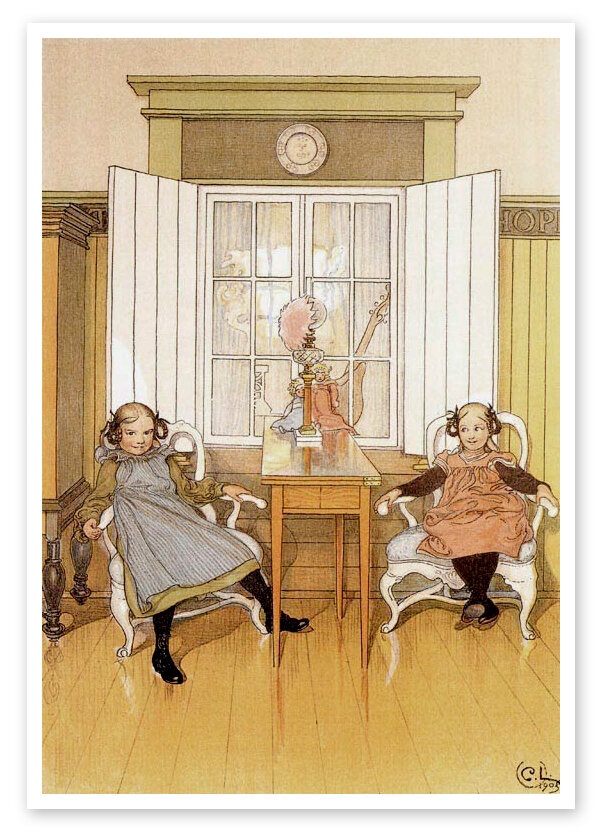The Kirsten Project | Revisiting the Art of Carl Larsson
/Above: Ingrid E, Watercolor, 1908, Esbjörn, 1900 and Children of Carpenter Helberg 1906, Little Lie-A-Bed’s Sad Breakfast, 1900, (The date is confusing, but the museum holding this piece gives 1900 as the date. Based on his daughter’s ages, this was probably Brita or Kersti), Kersti’s Friend Comes Visiting, 1905
When I started The Kirsten Project in 2019, I was pointed toward the work of Swedish artist Carl Larsson by Kirsten series illustrator Renée Graef. Renée told me his work was very influential in the early days at Pleasant Company. I’ve had a lot of fun reviewing all of Larsson’s work and finding elements that I believe inspired both Renée and Pleasant Compant as a whole. Last year, I posted his work featuring farm scenes and the striped fölkläde (apron) that may have inspired Kirsten’s world, but today I’d like to call your attention to another textile that shows up a lot in Carl’s work - narrow blue and white striped fabric.
I have a strong feeling that Kirsten’s summer outfit - a blue and white striped dress with straw hat and black band was based on the watercolor painting Ingrid E in 1908 (top image). It doesn’t end here! There are many examples of Larsson’s wife, sons, daughters (including Kersti!) and home textiles featuring the pale blue and white.
Notice the braids and white piping at the sleeve head of the dress in Little Lie-A-Bed’s Sad Breakfast. I think those elements could have further inspired Kirsten’s summer dress! Could Esbjörn’s little red boot be an inspiration for the red boots the Kirsten doll wears in the catalog?
So what does all this say and how does it relate to Kirsten Saves the Day? Blue and white stripes were a popular textile in the late 1800s into the Edwardian era. That doesn’t mean they didn’t exist in 1854, but they were more of a trend fifty years later (think Samantha’s timeline). The majority of extant blue and white striped dresses I found were all consistent with this period as well. That’s why I think these images inspired Kirsten’s summer dress versus something from the mid 19th century.
Also! There was another time that these stripes were the popular - the 1980s. Other eighties trends we see incorporated into Kirsten’s looks are her blue Meet dress, her hairstyle (bangs) and her Fana sweater. It makes a lot of sense that the time when a product was developed finds it’s way into the design. Can you think of anything else that was decidedly 80s but also works for the 1850s?
A Cozy Corner, Pencil and Watercolor, 1894 Carl Larsson
The Kitchen, 1895, Carl Larsson
Playing Scales, 1898, Pencil and Watercolor, Carl Larson
The First Lesson, 1903, Pencil and Watercolor, Carl Larsson
Mother and Daughter, 1903, Watercolor, Carl Larsson
My Little Farm, 1904, Carl Larsson
Brother and Sister, 1911, Carl Larsson
PS. Two of Larsson’s other daughters were named Lisbeth and Brita!


















































